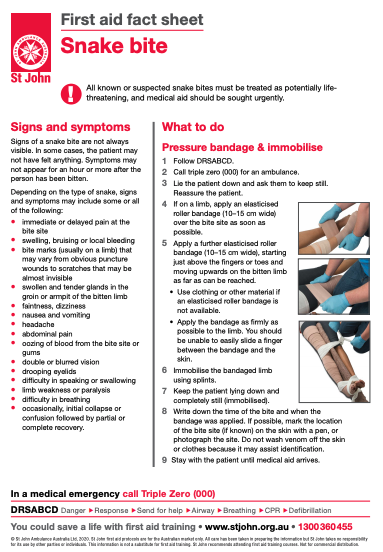Snake Awareness Policy
POLICY CONTENT
Early Education and Care services may be located in bush settings or visit bush settings as part of their educational program where it is known that snakes may be active and present. Snakes are most prevalent during Spring or Summer but could be encountered at any time of the year- especially on sunny days.Unprovoked, snakes rarely attack humans and are generally shy, timid animals that will avoid conflict if given the opportunity. Snakes are protected under the Nature Conservation Act 1992 and it is an offence to kill or injure them. The greatest risk of a snake bite from venomous snakes is from people trying to kill or handle them.
Our School is committed to providing a safe and healthy environment for children and staff whilst being respectful of wildlife in and around our environment. We aim to minimise the potential risk of injury from a snake bite by educating children and staff about the risks associated with snakes.
NATIONAL QUALITY STANDARD (NQS)
| QUALITY AREA 2: Children's Health and Safety |
|---|
| 2.2 | Safety | Each child is protected. |
| 2.2.1 | Supervision | At all times, reasonable precautions and adequate supervision ensure children are protected from harm and hazard. |
| 2.2.2 | Incident and emergency | Plans to effectively manage incidents and emergencies are developed in consultation with relevant authorities, practiced and implemented. |
| QUALITY AREA 3: Physical Environment |
|---|
| 3.2.3 | Environmentally responsible | The School cares for the environment and supports children to become environmentally responsible |
| QUALITY AREA 7: Governance and Leadership |
|---|
| 7.1.2 | Management Systems | Systems are in place to manage risk and enable the effective management and operation of a quality school. |
PURPOSE
We aim to ensure every reasonable precaution is taken to protect children and staff from harm and hazards likely to cause injury, including the potential risk from snake bites. This policy aims to define the risks of snakes within our school environment, the necessary strategies implemented to minimise the risk of snake bites and the appropriate medical response if required.SCOPE
This policy applies to children, families, staff, management, and visitors of the School.SNAKES
Australia has around 170 species of land snakes, some equipped with venom more toxic than any other snakes in the world. Some of the most dangerous snakes belong to the front-fanged group including the tiger snake, brown snake, eastern taipan, death adder and mulga or king brown snake. Although less venomous than many other Australian snakes, the red-bellied black snake is quite common in urban areas of NSW. Snake bites can be potentially fatal so immediate medical assistance should be sought for all cases of suspected snake bite.Snakes are not naturally aggressive and always prefer to retreat. They will only attack humans if hurt or provoked. People are most likely to be bitten when attempting to kill or handle a snake.
IMPLEMENTATION
Management and Nominated Supervisor will ensure:- conduct a risk assessment to identify the potential risk of encountering a snake on the school premises
- develop an emergency plan and procedure to include the response if encountering a snake and emergency first aid required in case of a snake bite
- provide a snake identification chart for snakes found in our local area for educators and staff
- provide emergency first aid training for all educators and staff annually including updates each ‘snake season’ of immobilisation techniques
- ensure an emergency action plan is displayed in a prominent location should a snake bite occur
- ensure First Aid Kits contain compression bandages
- ensure daily inspections of the outdoor and indoor learning environment are conducted prior to children arriving at the school
- ensure lawns and gardens are well maintained
- cut any long grass around the boundaries of the premises
- remove snake habitats such as piles of timber, compost heaps or sheets of galvanized iron from around the premise
- maintain clean surroundings around any animal housing/cages to reduce any potential mice population (a food source for snakes)
- reptile proof any chicken or other animal enclosures
- ensure pet food and water bowls are not accessible to wildlife
- provide information to families about snake awareness and recommended responses if encountering a snake
- educate children about how to respond to a snake sighting or encounter at the School or when participating on an excursion
- have the contact number of WIRES or other licensed snake handler readily available to assist in rescuing the snake if the snake cannot return to its natural environment - for example the snake is located in a garden shed or storage container or the snake is located inside and is unable to exit the building/premises
- follow procedures for notification of a serious incident in the unlikely event of a staff member or child being bitten by a snake
- complete an Incident, Injury, Trauma and Illness Record in the event of a snake bite
- ensure all educators and staff wear enclosed footwear at all times.
- examine the School grounds during their daily indoor and outdoor safety checks to ensure no snakes are sighted
- ensure no animal food or water is left out for wildlife overnight
- become familiar and confident with the School’s emergency evacuation policies and procedures in case of a snake encounter or snake bite
- always leave snakes alone
- be aware of snake species inhabiting the local area
- participate in annual First Aid training
- ensure the First Aid Kit is easily accessible and contains compression bandages
- notify the Nominated Supervisor/Responsible Person/Approved Provider immediately if a snake is sighted
- wear adequate clothing and enclosed shoes at all times
- educate children about snakes and snake bite prevention behaviours
- ensure children are reminded on a regular basis that if they encounter a snake, to move away quietly and report the sighting to an educator
- educate children not to put their hands into hollow logs or rock crevices.
ENCOUNTERING A SNAKE
If a snake is sighted or encountered at the School educators and staff will:- inform children to move away quietly
- remove all children and staff from the immediate area, or evacuate the room until snake is removed if indoors
- isolate this area until the snake is removed or moves
- note the location of the snake
- if possible, monitor the snake from a safe distance (at least 5 metres away)
- if snake remains and is perceived to be a threat, contact local snake handler or WIRES
- if indoors, close doors to the room and place towels along the bottom of the doors so the snake cannot move to another area and wait for snake handler to remove the snake
- do not approach the snake or try to contain it.
EMERGENCY SNAKE BITE ACTION PLAN
- conduct a primary survey of the area - do not attempt to catch or kill the snake
- stay calm and call for help - have someone call 000 for an ambulance
- reassure the child/adult and encourage them to keep calm and still
- immediately apply a firm bandage over the bite marks or scratches
- apply Pressure Immobilisation Technique (see Appendix 1)
- maintain continued pressure and immobilise ensuring the child/adult does not move
- rest and reassure the patient
- do not take off clothing
- do not wash bite as a venom sample can be used to identify the snake
- do not cut or suck the bite to drain venom
- do not apply a tourniquet
- be prepared - resuscitation may be required
Families will:
- familiarise themselves with the Snake Awareness Policy
- ensure their child wears closed shoes to the School
- reinforce snake awareness behaviours with their child - especially during ‘snake season’
- provide feedback to the School regarding this policy for review and improvement
APPENDIX 1
Pressure Immobilisation Bandage
A pressure immobilisation bandage is recommended for anyone bitten by a venomous snake. This involves firmly bandaging the area of the body involved, such as the arm or leg, and keeping the person calm and still until medical help arrives.Follow these steps to apply a pressure immobilisation bandage:
- first put a pressure bandage over the bite itself. It should be tight, and you should not be able to easily slide a finger between the bandage and the skin.
- then use a heavy crepe or elasticised roller bandage to immobilise the whole limb. Start just above the fingers or toes of the bitten limb and move upwards on the limb as far as the body. Splint the limb including joints on either side of the bite.
- keep the person and the limb completely at rest. If possible, mark the site of the bite on the bandage with a pen.
Poster
St John Ambulance: First aid fact sheet snake bite
SOURCE
Australian Children’s Education & Care Quality Authority. (2014).Australian Venom Research Unit, University of Melbourne avru.org
Australian Capital Territory Government Environment, Planning and Sustainable Development Directorate - Environment Urban Wildlife Snakes.
Education and Care Services National Regulations. (2011).
Guide to the Education and Care Services National Law and the Education and Care Services National Regulations. (2017).
Guide to the National Quality Framework. (2017). (Amended 2020).
Health Direct healthdirect.gov.au/snake-bites
Revised National Quality Standard. (2018).
First aid fact sheet snake bite - St John Ambulance Australia. (2020).
Did this answer your question?
If you still have a question, we’re here to help. Contact us
